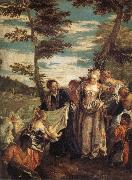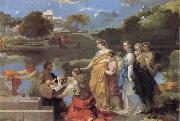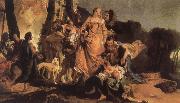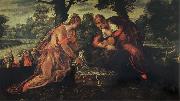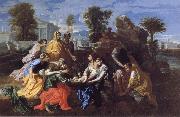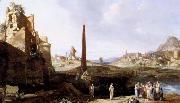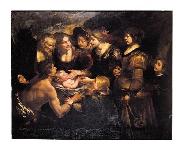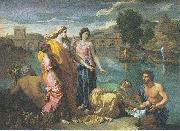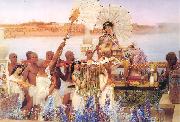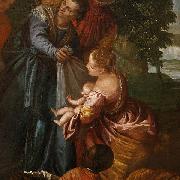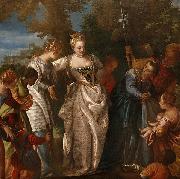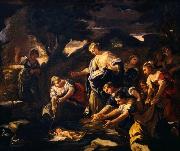Wholesale Oil Painting No Minimum |
|||||||||||
|
|
|||||||||||

|
|||||||||||
|
|
|
||||||||
|
|
||||||||
The Finding of Moses
The Finding of Moses Painting ID:: 191 |
1904 1904 |
|||||||
|
|
||||||||
Paolo VeroneseItalian Mannerist Painter, ca.1528-1588 Italian painter and draughtsman. With Titian and Tintoretto he makes up the triumvirate of great painters of the late Renaissance in Venice. He is known as a supreme colourist and for his illusionistic decorations in both fresco and oil. His large paintings of biblical feasts executed for the refectories of monasteries in Venice and Verona are especially celebrated. He also produced many altarpieces, history and mythological paintings and portraits. His compositional sketches in pen, ink and wash, figure studies in chalk, and chiaroscuro modelli and ricordi form a significant body of drawings. |
||||||||
|
|
||||||||
|
|
The Finding of Moses
The Finding of Moses Painting ID:: 33507 |
mk86
c.1570-1575
Oil on canvas
50x43cm
Madrid,Museo del Prado
mk86 c.1570-1575 Oil on canvas 50x43cm Madrid,Museo del Prado |
||||||
|
|
||||||||
Bourdon, SebastienFrench, 1616-1671.French painter. Bourdon was active in Rome (1634 C37), in Sweden (1652 C54) as Queen Christina's court portrait painter, and in Paris; he also worked in his native Montpellier, where he painted The Fall of Simon Magus for the cathedral. The Finding of Moses is in the National Gallery of Art, Washington, D.C. |
||||||||
|
|
||||||||
|
|
The Finding of Moses
The Finding of Moses Painting ID:: 33609 |
mk86
c.1650
Oil on canvas
119.6x172.8cm
Washington,National Gallery of Art
mk86 c.1650 Oil on canvas 119.6x172.8cm Washington,National Gallery of Art |
||||||
|
|
||||||||
Giovanni Battista TiepoloItalian Rococo Era Painter, 1696-1770 Giovanni Battista Tiepolo was born in Venice on March 5, 1696. His father, who was part owner of a ship, died when Tiepolo was scarcely a year old, but the family was left in comfortable circumstances. As a youth, he was apprenticed to Gregorio Lazzarini, a mediocre but fashionable painter known for his elaborately theatrical, rather grandiose compositions. Tiepolo soon evolved a more spirited style of his own. By the time he was 20, he had exhibited his work independently, and won plaudits, at an exhibition held at the church of S. Rocco. The next year he became a member of the Fraglia, or painters guild. In 1719 he married Cecilia Guardi, whose brother Francesco was to become famous as a painter of the Venetian scene. They had nine children, among them Giovanni Domenico and Lorenzo Baldassare, who were also painters. In the 1720s Tiepolo carried out many large-scale commissions on the northern Italian mainland. Of these the most important is the cycle of Old Testament scenes done for the patriarch of Aquileia, Daniele Dolfin, in the new Archbishop Palace at Udine. Here Tiepolo abandoned the dark hues that had characterized his early style and turned instead to the bright, sparkling colors that were to make him famous. |
||||||||
|
|
||||||||
|
|
The Finding of Moses
The Finding of Moses Painting ID:: 40544 |
mk156
1730
Oil on canvas
202x342cm
mk156 1730 Oil on canvas 202x342cm |
||||||
|
|
||||||||
TintorettoItalian Mannerist Painter, ca.1518-1594 His father was a silk dyer (tintore); hence the nickname Tintoretto ("Little Dyer"). His early influences include Michelangelo and Titian. In Christ and the Adulteress (c. 1545) figures are set in vast spaces in fanciful perspectives, in distinctly Mannerist style. In 1548 he became the centre of attention of artists and literary men in Venice with his St. Mark Freeing the Slave, so rich in structural elements of post-Michelangelo Roman art that it is surprising to learn that he had never visited Rome. By 1555 he was a famous and sought-after painter, with a style marked by quickness of execution, great vivacity of colour, a predilection for variegated perspective, and a dynamic conception of space. In his most important undertaking, the decoration of Venice's Scuola Grande di San Rocco (1564 C 88), he exhibited his passionate style and profound religious faith. His technique and vision were wholly personal and constantly evolving. |
||||||||
|
|
||||||||
|
|
The Finding of Moses
The Finding of Moses Painting ID:: 41281 |
mk161
Oil on canvas
30x52
mk161 Oil on canvas 30x52 |
||||||
|
|
||||||||
Nicolas PoussinFrench 1594-1665 Nicolas Poussin Galleries The finest collection of Poussin's paintings, in addition to his drawings, is located in the Louvre in Paris. Besides the pictures in the National Gallery and at Dulwich, England possesses several of his most considerable works: The Triumph of Pan is at Basildon House, near to Pangbourne, (Berkshire), and his great allegorical painting of the Arts at Knowsley. The later version of Tancred and Erminia is at the Barber Institute in Birmingham. At Rome, in the Colonna and Valentini Palaces, are notable works by him, and one of the private apartments of Prince Doria is decorated by a great series of landscapes in distemper. Throughout his life he stood aloof from the popular movement of his native school. French art in his day was purely decorative, but in Poussin we find a survival of the impulses of the Renaissance coupled with conscious reference to classic work as the standard of excellence. In general we see his paintings at a great disadvantage: for the color, even of the best preserved, has changed in parts, so that the harmony is disturbed; and the noble construction of his designs can be better seen in engravings than in the original. Among the many who have reproduced his works, Audran, Claudine Stella, Picart and Pesne are the most successful. |
||||||||
|
|
||||||||
|
|
The Finding of Moses
The Finding of Moses Painting ID:: 43226 |
mk170
1651
Oil on canvas
116x177.5cm
mk170 1651 Oil on canvas 116x177.5cm |
||||||
|
|
||||||||
BREENBERGH, BartholomeusDutch Baroque Era Painter, ca.1598-1657 Dutch painter, draughtsman and etcher. He was one of at least eight children of a wealthy Protestant family in Deventer, where his father was the town pharmacist. After his father's death in 1607, the family left Deventer, probably moving to Hoorn. No artist then living in Hoorn could plausibly have been Breenbergh's teacher, and given the fact that his earliest works reveal the stylistic influence of the Pre-Rembrandtists, it is more probable that he was apprenticed in Amsterdam. In 1619 he was called upon to give testimony in Amsterdam: on this occasion his profession was listed as 'painter'. His oeuvre can be divided stylistically and iconographically into two distinct groups. He belonged to the first generation of DUTCH ITALIANATES, northern artists who travelled to Italy in the 1620s and were inspired by the light and poetry of the southern landscape. The work of this period consists of numerous Italianate landscape drawings and paintings. |
||||||||
|
|
||||||||
|
|
The Finding of Moses
The Finding of Moses Painting ID:: 52612 |
1639 Oil on panel, 48 x 81 cm 1639 Oil on panel, 48 x 81 cm |
||||||
|
|
||||||||
Gioacchino TomaItalian , Galatina 1836 - Napoli 1891 Italian painter. He was orphaned at the age of six and spent an unhappy childhood and adolescence in convents and poorhouses; these experiences would later provide subjects for his paintings. He was first taught drawing at the art school in the hospice for the poor in the Adriatic town of Giovinazzo, but in 1855 he moved to Naples, where he worked for an ornamental painter named Alessandro Fergola. In 1857 he was mistakenly arrested for conspiracy and exiled to Piedimonte d'Alife, 60 km from Naples, where he was initiated into the secret society of the Carbonari by some local liberal aristocrats who also became his first patrons. His paintings for them were mainly still-lifes, largely in the traditional Neapolitan style. On his return to Naples in 1858 he became a student at the Accademia di Belle Arti, attending the classes of Domenico Morelli, who influenced such early works as Erminia (1859; Naples, Pal. Reale). Toma fought for two years with Garibaldi in the campaign for the unification of Italy, then returned to painting, |
||||||||
|
|
||||||||
|
|
The Finding of Moses
The Finding of Moses Painting ID:: 67644 |
Dimensions 156,7 x 193,8 cm Dimensions 156,7 x 193,8 cm |
||||||
|
|
||||||||
Nicolas PoussinFrench 1594-1665 Nicolas Poussin Galleries The finest collection of Poussin's paintings, in addition to his drawings, is located in the Louvre in Paris. Besides the pictures in the National Gallery and at Dulwich, England possesses several of his most considerable works: The Triumph of Pan is at Basildon House, near to Pangbourne, (Berkshire), and his great allegorical painting of the Arts at Knowsley. The later version of Tancred and Erminia is at the Barber Institute in Birmingham. At Rome, in the Colonna and Valentini Palaces, are notable works by him, and one of the private apartments of Prince Doria is decorated by a great series of landscapes in distemper. Throughout his life he stood aloof from the popular movement of his native school. French art in his day was purely decorative, but in Poussin we find a survival of the impulses of the Renaissance coupled with conscious reference to classic work as the standard of excellence. In general we see his paintings at a great disadvantage: for the color, even of the best preserved, has changed in parts, so that the harmony is disturbed; and the noble construction of his designs can be better seen in engravings than in the original. Among the many who have reproduced his works, Audran, Claudine Stella, Picart and Pesne are the most successful. |
||||||||
|
|
||||||||
|
|
The Finding of Moses
The Finding of Moses Painting ID:: 82167 |
Date 1638(1638)
English: Oil on canvas
Dimensions 94 x 121 cm
cjr Date 1638(1638) English: Oil on canvas Dimensions 94 x 121 cm cjr |
||||||
|
|
||||||||
Laura Theresa Alma-Tadema(1852 C 15 August 1909 in Hindhead) was from 1871 the second wife of the painter Lawrence Alma-Tadema and a painter in her own right. A daughter of Dr George Napoleon Epps (who was brother of Dr John Epps), her two sisters were also painters (Emily studied under John Brett, a Pre-Raphaelite, and Ellen under Ford Madox Brown), whilst Edmund Gosse and Rowland Hill were her brothers-in-law. It was at Madox Brown's home that Alma-Tadema first met her in December 1869, when she was aged 17 and he 33. (His first wife had died in May that year.) He fell in love at first sight,and so it was partly her presence in London (and partly the fact that only in England had his work consistently sold) that influenced him into relocating in England rather than elsewhere when forced to leave the continent by the outbreak of the Franco Prussian War in July 1870. Arriving in London at the beginning of September 1870 with his small daughters and sister Artje, Alma-Tadema wasted no time in contacting Laura, and it was arranged that he would give her painting lessons. During one of these, he proposed marriage. As he was then thirty-four and Laura was now only eighteen, her father was initially opposed to the idea. Dr Epps finally agreed on the condition that they should wait until they knew each other better. They married in July 1871 and, though this second marriage proved childless, it also proved enduring and happy, with Laura acting as stepmother to her husband's children by his first marriage. The Paris Salon in 1873 gave Laura her first success in painting, and five years later, at the Paris International Exhibition, she was one of only two English women artists exhibited. |
||||||||
|
|
||||||||
|
|
The finding of Moses
The finding of Moses Painting ID:: 85686 |
1904(1904)
Medium Oil on canvas
Dimensions 137.5 x 213.4 cm (54.1 x 84 in)
cyf 1904(1904) Medium Oil on canvas Dimensions 137.5 x 213.4 cm (54.1 x 84 in) cyf |
||||||
|
|
||||||||
Nicolas PoussinFrench 1594-1665 Nicolas Poussin Galleries The finest collection of Poussin's paintings, in addition to his drawings, is located in the Louvre in Paris. Besides the pictures in the National Gallery and at Dulwich, England possesses several of his most considerable works: The Triumph of Pan is at Basildon House, near to Pangbourne, (Berkshire), and his great allegorical painting of the Arts at Knowsley. The later version of Tancred and Erminia is at the Barber Institute in Birmingham. At Rome, in the Colonna and Valentini Palaces, are notable works by him, and one of the private apartments of Prince Doria is decorated by a great series of landscapes in distemper. Throughout his life he stood aloof from the popular movement of his native school. French art in his day was purely decorative, but in Poussin we find a survival of the impulses of the Renaissance coupled with conscious reference to classic work as the standard of excellence. In general we see his paintings at a great disadvantage: for the color, even of the best preserved, has changed in parts, so that the harmony is disturbed; and the noble construction of his designs can be better seen in engravings than in the original. Among the many who have reproduced his works, Audran, Claudine Stella, Picart and Pesne are the most successful. |
||||||||
|
|
||||||||
|
|
The Finding of Moses
The Finding of Moses Painting ID:: 85779 |
Oil on canvas
Dimensions 94 x 121 cm
cyf Oil on canvas Dimensions 94 x 121 cm cyf |
||||||
|
|
||||||||
Paolo VeroneseItalian Mannerist Painter, ca.1528-1588 Italian painter and draughtsman. With Titian and Tintoretto he makes up the triumvirate of great painters of the late Renaissance in Venice. He is known as a supreme colourist and for his illusionistic decorations in both fresco and oil. His large paintings of biblical feasts executed for the refectories of monasteries in Venice and Verona are especially celebrated. He also produced many altarpieces, history and mythological paintings and portraits. His compositional sketches in pen, ink and wash, figure studies in chalk, and chiaroscuro modelli and ricordi form a significant body of drawings. |
||||||||
|
|
||||||||
|
|
The finding of Moses
The finding of Moses Painting ID:: 91310 |
circa 1580
Medium oil on canvas
cyf circa 1580 Medium oil on canvas cyf |
||||||
|
|
||||||||
Paolo VeroneseItalian Mannerist Painter, ca.1528-1588 Italian painter and draughtsman. With Titian and Tintoretto he makes up the triumvirate of great painters of the late Renaissance in Venice. He is known as a supreme colourist and for his illusionistic decorations in both fresco and oil. His large paintings of biblical feasts executed for the refectories of monasteries in Venice and Verona are especially celebrated. He also produced many altarpieces, history and mythological paintings and portraits. His compositional sketches in pen, ink and wash, figure studies in chalk, and chiaroscuro modelli and ricordi form a significant body of drawings. |
||||||||
|
|
||||||||
|
|
The finding of Moses
The finding of Moses Painting ID:: 91311 |
circa 1580
Medium oil on canvas
cyf circa 1580 Medium oil on canvas cyf |
||||||
|
|
||||||||
Giuseppe Simonelli(Naples, c.1650 - 1710) was an Italian painter. Born in Naples around 1650, Simonelli was one of the most important painters of the school of Luca Giordano. His early works were often retouched by Giordano to such a degree that some of them were confused with those of the master. He learned Giordanoes art so well that when the master left Naples for the Spanish court in 1692, he was assigned the task of completing the unfinished Neapolitan works for delivery to clients. Reliable details of his own production are available as from 1686, when he received the final payment for a painting of Holy Martyrs for the Jesuit college in Trapani. His most celebrated works are the series of 28 paintings for the Church of the Annunziata in Aversa, produced between 1702 and 1703 together with his brother Gennaro. He worked continuously right up to his death in 1710. |
||||||||
|
|
||||||||
|
|
The Finding of Moses
The Finding of Moses Painting ID:: 93056 |
between 1680(1680) and 1690(1690)
Medium oil on canvas
Dimensions Height: 64 cm (25.2 in). Width: 77 cm (30.3 in).
cjr between 1680(1680) and 1690(1690) Medium oil on canvas Dimensions Height: 64 cm (25.2 in). Width: 77 cm (30.3 in). cjr |
||||||
|
|
||||||||
|
Giuseppe Simonelli (Naples, c.1650 - 1710) was an Italian painter. Born in Naples around 1650, Simonelli was one of the most important painters of the school of Luca Giordano. His early works were often retouched by Giordano to such a degree that some of them were confused with those of the master. He learned Giordanoes art so well that when the master left Naples for the Spanish court in 1692, he was assigned the task of completing the unfinished Neapolitan works for delivery to clients. Reliable details of his own production are available as from 1686, when he received the final payment for a painting of Holy Martyrs for the Jesuit college in Trapani. His most celebrated works are the series of 28 paintings for the Church of the Annunziata in Aversa, produced between 1702 and 1703 together with his brother Gennaro. He worked continuously right up to his death in 1710. The Finding of Moses between 1680(1680) and 1690(1690) Medium oil on canvas Dimensions Height: 64 cm (25.2 in). Width: 77 cm (30.3 in). cjr |
||||||||
|
|
||||||||
|
Prev Next
|
||||||||
|
|
||||||||
|
Related Paintings to Giuseppe Simonelli :. |
||||||||
|
|
||||||||
|
CONTACT US |


